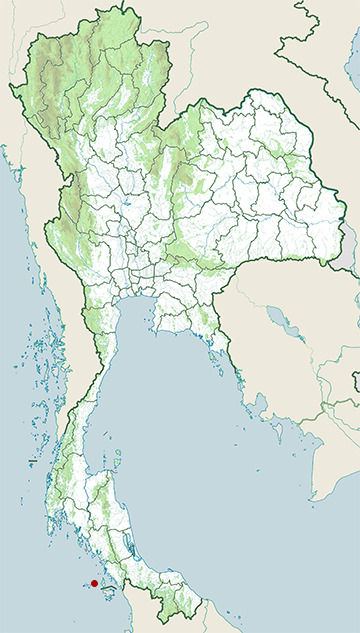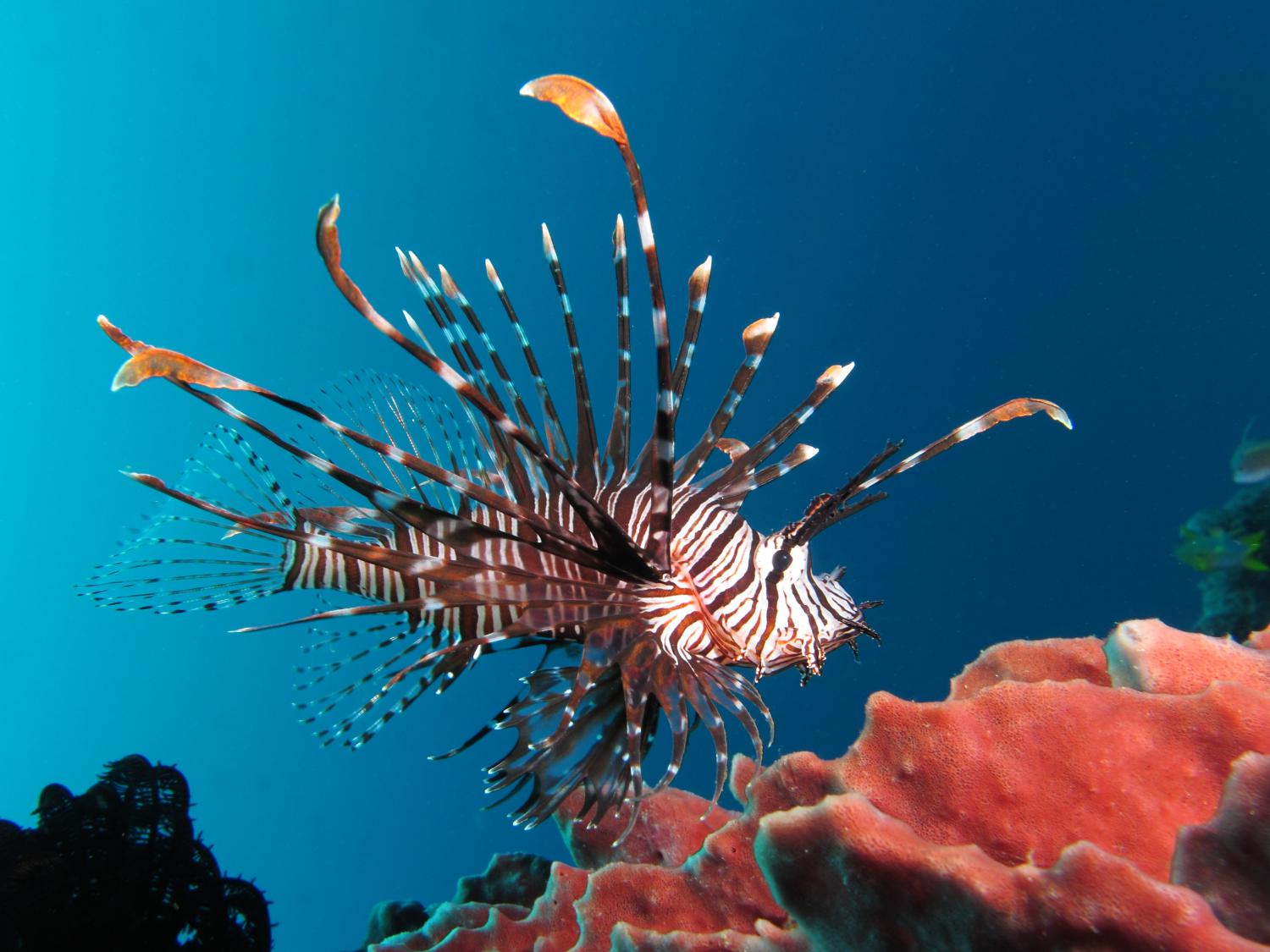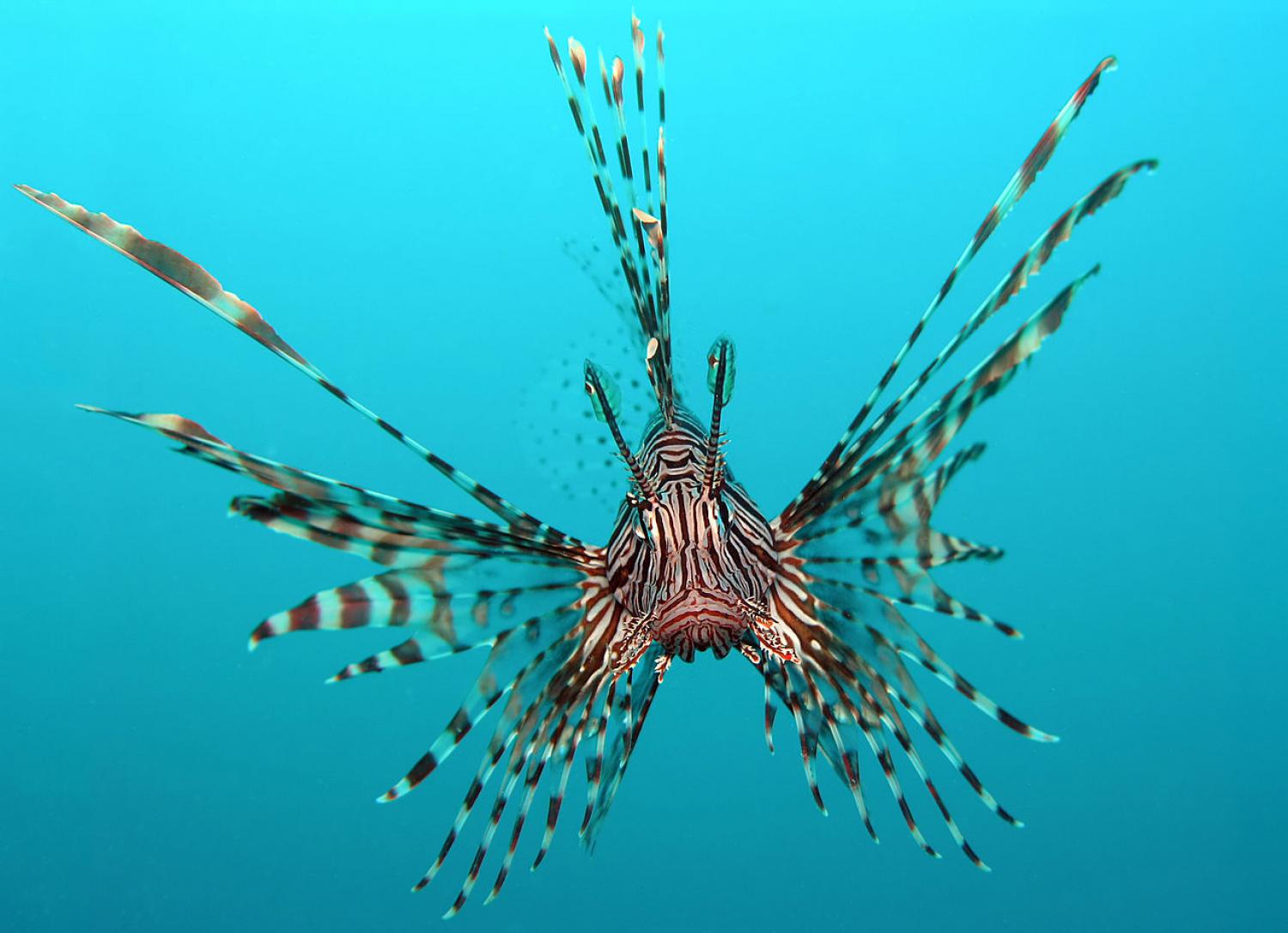Species of Thailand
Red lionfish
Pterois volitans
Carolus Linnaeus, 1758
The red lionfish (Pterois volitans) or zebrafish is a venomous coral reef fish in the family Scorpaenidae, order Scorpaeniformes. It is mainly native to the Indo-Pacific region, but has become an invasive species in the Caribbean Sea, as well as along the East Coast of the United States and East Mediterranean.
P. volitans and a similar relative, Pterois miles, have both been deemed invasive species. Red lionfish are clad in white stripes alternated with red/maroon/brown stripes. Adults in this species can grow as large as 47 cm (18.5 in) in length, making it one of the largest species of lionfish in the ocean, while juveniles are typically shorter than 1 cm. The average red lionfish lives around 10 years. As with many species within the family Scopaenidae, it has large, venomous spines that protrude from the body, similar to a mane, giving it the common name lionfish. The venomous spines make the fish inedible or deter most potential predators. Lionfish reproduce monthly and are able to quickly disperse during their larval stage for expansion of their invasive region. No definitive predators of the lionfish are known, and many organizations are promoting the harvest and consumption of lionfish in efforts to prevent further increases in the already high population densities.
Distribution
P. volitans is native to the Indo-Pacific region, including the western and central Pacific and off the coast of western Australia. However, the species has been accidentally introduced into the Western Atlantic, becoming an invasive species there and in the northern Gulf of Mexico as well.
Reproduction
They are mainly a solitary species and courting is the only time they aggregate, generally one male with several females. Both P. volitans and P. miles are gonochoristic, only showing sexual dimorphism during reproduction. Similar courtship behaviors are observed in all Pterois species, including circling, sidewinding, following, and leading. The lionfish are mostly nocturnal, leading to the behaviors typically around nightfall and continuing through the night. After courtship, the female releases two egg masses, fertilized by the male before floating to the surface. The embryos secrete an adhesive mucous allowing them to attach to nearby intertidal rocks and corals before hatching. During one mating session, females can lay up to 30, 000 eggs. However, it has been observed that females will lay more eggs in the warmer months.
Early life history and dispersal
Although little is known about the larval stage of the lionfish, some traits of the larvae include a large head, a long, triangular snout, long, serrated head spines, a large pelvic spine, and coloration only in the pelvic fins. Larvae hatch 36 hours after fertilization. They are good swimmers and can eat small ciliates just four days after conception. The larval stage is the shortest stage of the lionfish's life, with a duration of about one month.
Venom
Lionfish venomous dorsal spines are used purely for defense. When threatened, the fish often faces its attacker in an upside-down posture which brings its spines to bear. However, its sting is usually not fatal to humans. Envenomed humans will experience extreme pain, and possibly headaches, vomiting, and breathing difficulties. A common treatment is soaking the afflicted area in hot water, as very few hospitals carry specific treatments. However, immediate emergency medical attention is strongly recommended, as some people are more sensitive to the venom than others.
As an invasive species
Two of the 15 species of Pterois, P. volitans and P. miles, have established themselves as significant invasive species off the East Coast of the United States and in the Caribbean. About 93% of the invasive lionfish population is the red lionfish. The red lionfish was likely first introduced off the Florida coast in the early to mid-1980s, almost certainly from the aquarium trade. Adult lionfish specimens are now found along the East Coast from Cape Hatteras, North Carolina, to Florida, and in Bermuda, the Bahamas, and throughout the Caribbean, including the Turks and Caicos, Haiti, Cuba, the Dominican Republic, Guadeloupe, Puerto Rico, St. Croix, Belize, Honduras, Aruba, Cayman Islands, Colombia and Mexico.
Predators and prey
In its invasive range, few predators of the lionfish have been documented. Most larger Atlantic and Caribbean fish and sharks that should be able to eat the lionfish have not recognized them as prey, likely due to the novelty of the fish in the invaded areas. Lionfish have, however, been found in the stomachs of Nassau and tiger groupers in the Bahamas, but the former is critically endangered and therefore highly unlikely to provide significant predation. In its native range, two species of moray eels were found preying on lionfish. The Bobbit worm, an ambush predator, has been filmed preying upon lionfish in Indonesia; similar species inhabit the Caribbean. , The lionfish themselves are voracious feeders and have outcompeted and filled the niche of the overfished snapper and grouper. When hunting, they corner prey using their large fins, then use their quick reflexes to swallow the prey whole. They hunt primarily from late afternoon to dawn. High rates of prey consumption, a wide variety of prey, and increasing abundance of the fish lead to concerns the fish may have a very active role in the already declining trend of fish densities. As the fish become more abundant, they are becoming a threat to the fragile ecosystems they have invaded. Between outcompeting similar fish and having a varied diet, the lionfish is drastically changing and disrupting the food chains holding the marine ecosystems together. As these chains are disrupted, declining densities of other fish populations are found, as well as declines in the overall diversity of coral reef areas.
This article uses material from Wikipedia released under the Creative Commons Attribution-Share-Alike Licence 3.0. Eventual photos shown in this page may or may not be from Wikipedia, please see the license details for photos in photo by-lines.
Scientific classification
- Kingdom
- Animalia
- Phylum
- Chordata
- Class
- Actinopterygii
- Order
- Scorpaeniformes
- Family
- Scorpaenidae
- Genus
- Pterois
- Species
- Pterois volitans
Photos
Please help us review our species pages if wrong photos are used or any other details in the page is wrong. We can be reached via our contact us page.
Range Map

- Tarutao National Marine Park

